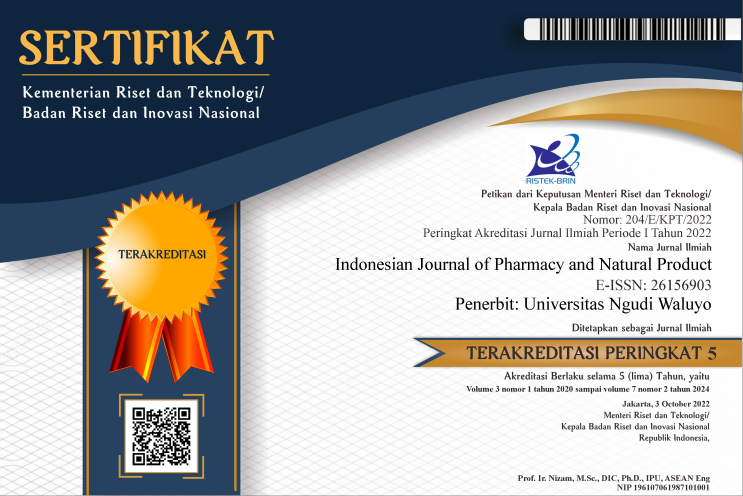Identifikasi Senyawa Flavonoid Ekstrak Etanol 96% Cacing Tambelo (Bactronophorus Thoracites) Menggunakan Metode KLT
Identification of Flavonoid Compounds of 96% Ethanol Extract of Tambelo Worm (Bactronophorus Thoracites) Using KLT Method
DOI:
https://doi.org/10.35473/ijpnp.v8i01.3713Keywords:
Cacing Tambelo (Bactronophorus thoracites), Maserasi, Kromatografi Lapis Tipis (KLT), FlavonoidAbstract
Tambelo worms (Bactronophorus thoracites) are worms that live in decaying mangrove trees. The purpose of this study was to analyze the flavonoid compound content in tambelo worms (Bactronophorus thoracites) from Tepian Village, North Kalimantan Province. This study uses descriptive observational method which includes the examination of data on the identification of secondary metabolite compounds, especially color changes in thin layer chromatography test results in the form of retention factor (RF) values. The tambelo worms used in this study have been determined at the National Research and Innovation Agency (BRIN) in December 2024. In this study, the extraction method is maceration method and the identification of flavonoid compound using Thin Layer Chromatography (TLC). The results of tambelo worm extract after spraying cyroborate reagent produced a yellow stain (RF = 0.40), and produced a bright blue fluorescent stain (RF = 0.38) when observed using UV light 366 nm. The conclusion from the results of this study is that tambelo worm extract (Bactronophorus thoracites) is positive for flavonoids. Thin Layer Chromatography test results using mobile phase n-hexan:ethyl acetate (1:3) for flavonoids.
ABSTRAK
Cacing tambelo (Bactronophorus thoracites) merupakan cacing yang hidup dipohon bakau lapuk dan membusuk. Tujuan penelitian ini untuk menganalisis kandungan senyawa flavonoid pada cacing tambelo (Bactronophorus thoracites) asal Desa Tepian Provinsi Kalimantan Utara. Penelitian ini menggunakan metode observasional deskriptif yang meliputi pemeriksaan data hasil identifikasi senyawa metabolit sekunder, khususnya perubahan warna pada hasil uji kromatografi lapis tipis berupa nilai faktor retensi (RF). Cacing tambelo yang dipakai pada penelitian ini telah dideterminasi di Badan Riset dan Inovasi Nasional (BRIN) pada bulan desember 2024. Pada penelitian ini ekstraksi menggunakan metode maserasi dan pengujian senyawa flavonoid menggunakan kromatografi lapis tipis (KLT). Hasil ekstrak cacing tambelo setelah penyemprotan reagen sitroborat menghasilkan bercak noda berwarna kuning (RF= 0,40), dan menghasilkan bercak noda berflourisensi biru terang (RF= 0,38) pada saat diamati menggunakan sinar UV 366 nm. Kesimpulan dari hasil penelitian ini bahwa ekstrak cacing tambelo (Bactronophorus thoracites) positif mengandung flavonoid. Hasil uji Kromatografi Lapis Tipis menggunakan fase gerak n-heksan:etil asetat (1:3) untuk flavonoid.
References
Afiddah, B. N., Zahra, F. B. P., Sukmawati, I., Malik, M. O., Putra, S. A., Winarti, S. A., Suciyanti, Q. P., Ikhtianingsih, W., & Gunarti, N. S. (2023). REVIEW ARTIKEL: SENYAWA FITOKIMIA SERTA AKTIVITAS FARMAKOLOGI CACING. Jurnal Buana Farma, 3(2), 33–40. https://doi.org/10.36805/jbf.v3i2.570
Amri, A. U. (2024). Uji Aktivitas Antibakteri Ekstrak Etanol Daun Gaharu (Aquilaria malaccensis) Dengan Menggunakan Metode KLT-Bioautografi. Makassar Pharmaceutical Science Journal (MPSJ), 1(4).
Anwar, L. O., Fatmah Sari, S., Ambo Elo, A., Rosmawati, R., Nurdiyanty Nurdin, I., & Said, A. (2021). Uji Toksisitas Ekstrak Cacing Tambelo (Bactronophorus thoracites) dengan Metode Brine Shrimp Lethality Test. Jurnal Pengolahan Hasil Perikanan Indonesia, 24(2), 243–248. https://doi.org/10.17844/jphpi.v24i2.34880
Charismawati, N. A. (2021). Analisis Kadar Hidrokuinon Pada Krim Pemutih Yang Beredar Online Dengan Metode Kromatografi Lapis Tipis (Klt) Dan Spektrofotometri UV-Vis. Jurnal Kartika Kimia, 4(2). https://doi.org/10.26874/jkk.v4i2.79
Firawati, F., & Hasrida. (2024). Identifikasi Senyawa Flavonoid Daun Dempul Lelet (Glochidion rubrum BI). Jurnal Farmasi UIN Alauddin Makassar, 11(2), 22–29. https://doi.org/10.24252/jfuinam.v11i2.38763
Forestyana, D., & Arnida. (2020). Phytochemical Screenings And Thin Layer Chromatography Analysis Of Ethanol Extract Jeruju Leaf (Hydrolea Spinosa L.) Article History. Jurnal Ilmiah Farmako Bahari, 11(2), 113–124.
Hakim, A. R. (2023). Identifikasi Senyawa Flavonoid Ekstrak Daun Karinat. Sains Medisina, 1(3).
Hasanah, R. M., Narsih, U., & Dimas Abdul Azis, F. (2024). Identifikasi Flavonoid Ekstrak Kulit Buah Naga Merah (Hylocereus polyrhizus) secara Kromatografi Lapis Tipis (KLT) dengan Pelarut Etanol 96% dan Metanol 96%. JI-KES (Jurnal Ilmu Kesehatan), 8(1), 30–37. https://doi.org/10.33006/jikes.v8i1.792
Mustaqimah. (2023). Identifikasi Senyawa Flavonoid Ekstrak Etanol Daun Karinat Dengan Metode KLT. Sains Medisina, 1(2).
Ningsih, I. S., Chantri, M., & Advinda, L. (2023). Senyawa Aktif Flavonoid yang Terdapat Pada Tumbuhan. Jurnal Serambi Biologi, 8(2).
Salembeheu, B. E., Banilodu, L., & Semiun, C. G. (2022). UJI KANDUNGAN GIZI TAMBELO (Bactronophorus sp.) YANG DIBUDIDAYAKAN DI SUNGAI SIMATALU OLEH MASYARAKAT DESA SIMATALU KABUPATEN KEPULAUAN MENTAWAI PROVINSI SUMATERA BARAT. Spizaetus: Jurnal Biologi dan Pendidikan Biologi, 3(1), 1. https://doi.org/10.55241/spibio.v3i1.54
Wahyudi, A. T., & Minarsih, T. (2023). Pengaruh Ekstraksi dan Konsentrasi Etanol terhadap Kadar Flavonoid Total dan Aktivitas Antioksidan Ekstrak Jahe Emprit (Zingiber officinale var. Amarum). Indonesian Journal of Pharmacy and Natural Product, 6(01), 30–38. https://doi.org/10.35473/ijpnp.v6i01.2208
Werdiningsih, W., & Legowo, A. W. (2023). Identifikasi Senyawa Flavonoid Terhadap Rendemen Ekstrak Daun Pepaya Jepang (Cnidoscolus aconitifolius Mill.) Dengan Metode Ekstraksi Sokhletasi. Jurnal Pharma Bhakta, 3(2), 57–65.



